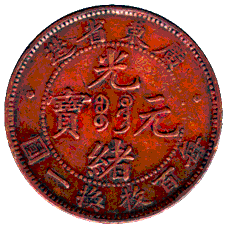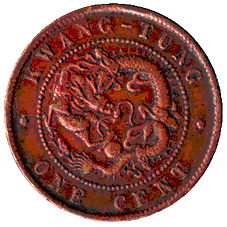| For the shortage of the old copper cash in the late Qing dynasty, the trandition casting method did not help economically to solve the problem. When Hongkong one cent copper coins were occasionaly in circulation with the value to ten cash coins in the local market of Kwangtung. The existence western style coinage in Hongkong directly influenced the Chinese mint authority.
The Acting Viceroy of Kwangtung and Kwangsi Province, Te Shou  consulted with Li Hung-chang consulted with Li Hung-chang  , his predecessor, decided to mint a new model copper coin called "T'ung Yuan" , his predecessor, decided to mint a new model copper coin called "T'ung Yuan" .
"T'ung Yuan" was first minted in Kwangtung in the 26th year of the Kuang Hsu reign (1900AD). The coin was minted by machine without hole in the center. It was equivalent to ten cash at the early beginning. The use of copper to make one "T'ung Yuan" is equal to six old cash coin only. .
"T'ung Yuan" was first minted in Kwangtung in the 26th year of the Kuang Hsu reign (1900AD). The coin was minted by machine without hole in the center. It was equivalent to ten cash at the early beginning. The use of copper to make one "T'ung Yuan" is equal to six old cash coin only.
The "T'ung Yuan" was quiet welcomed by the population for its convenience compared with the old cash coins. The Chinese government also encouraged other provinces to follow the good example of Kwangtung in order to solve the fiscal problem. Other provinces found it was profitable to mint "T'ung Yuan", they vied with each other to do the same business of minting the new coins. For the over-supply of the new copper coins, this caused the value of "T'ung Yuan" declined in the rate of exchange with silver dollars. In 1911, Its rate of exchange to the silver dollar was approximately dropped to 180 to 1 from 100 to 1 of the early beginning. |
| Description | Obverse | Mint Evolution & Peculiarity |
| No. 0027 |  |
This coin was first minted in Kwangtung Coin Bureau in 1900. Kwangtung Coin Bureau was founded in Canton City, (now Huang Hua Road, Canton) by Chang Chih-tung  , the viceroy of the Kwangtung and Kwangsi Provinces on 7 Mar 1887, the 13th year of the Kuang Hsu reign. The Mint was completed in Feb 1889. Machines were supplied by the Heatons Mint in London. , the viceroy of the Kwangtung and Kwangsi Provinces on 7 Mar 1887, the 13th year of the Kuang Hsu reign. The Mint was completed in Feb 1889. Machines were supplied by the Heatons Mint in London. On the obverse of this coin, four big Chinese characters inside beaded circle means Kuang Hsu valuable coin and the two Manchu characters in centre are "Pao Kwang". In the outer circle, Chinese characters above means made in Kwangtung Province, and the six Chinese characters below means every hundred equivalent to one dollar; two small stars on each side. On the reverse is the emblem of flaming dragon flying in clouds inside the beaded circle. In the outer circle, is the English inscriptions and two small stars on each side. An important thing I must point out that the dies were changed in 1904, This means that the same design Kwangtung "T'ung Yuan" is not so many existing today. [The standard content of "T'ung Yuan" in 1900: weighted 2 mace  or 0.2 tael or 0.2 tael  , with 95% copper, 4% lead and 1% tin ] , with 95% copper, 4% lead and 1% tin ] |
| Mint: Kwangtung | ||
| Wt. 7.3 g. | Reverse | |
| Diam. 27.8 mm |  | |
| Rareness E |
According to the No.1 Branch Report of Kwangtung Mint  , I give below the table of an incomplete record of the mintage of "T'ung Yuan" (10 cash) minted by Kwangtung Coin Bureau. I think this may be useful for you. , I give below the table of an incomplete record of the mintage of "T'ung Yuan" (10 cash) minted by Kwangtung Coin Bureau. I think this may be useful for you. |
| Date | Mintage ( piece ) |
| 1900AD - 1908AD | 1,211,487,000 |
| 1910AD | 15,276,000 |
Where is the Mint Mark
of the 10 Cash TAI-CHING-TI-KUO copper coin ?
 p.107, ISBN 7-218-00594-2/k.130
p.107, ISBN 7-218-00594-2/k.130 ,
,  1994, p.727, ISBN 7-5000-5469-6.
1994, p.727, ISBN 7-5000-5469-6.